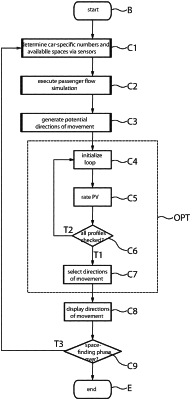| CPC B61L 15/0018 (2013.01) [G06Q 10/02 (2013.01); G06Q 10/04 (2013.01)] | 10 Claims |

|
1. A method for distributing passengers in a passenger train having a plurality of passenger cars on a basis of direction of movement indications, the method comprising:
determining, by a controller of the passenger train, for a respective passenger car, a number of passengers situated therein and/or a number of available spaces, by continuously detecting sensor signals from one or more sensors and check-in information transmitted by passenger mobile devices;
initializing, by the controller, a passenger flow simulation on a basis of the determined passenger car-specific numbers of passengers, the numbers of available spaces, and passenger car-specific geometry of the respective passenger car in order to simulate a movement of passengers in the passenger train, in real-time;
determining, by the controller, a multiplicity of potential directions of movement, for which a multiplicity of direction of movement-specific movement profiles are read in, each respective movement profile being empirical probability distributions that specify a speed, a direction, and a quantity of passengers that will typically move at a frequency within the respective passenger car;
executing, by the controller, the initialized passenger flow simulation for the respective movement profile, wherein the passenger flow simulation determines a passenger distribution for each passenger;
calculating, by the controller, using a numerical optimization method, distribution values specific the passenger distribution;
selecting, by the controller, from the multiplicity of potential directions of movement and depending on the distribution values, specific directions of movement; and
outputting, by the controller, the selected directions of movement as direction of movement indications on passenger-specific and/or location-specific direction indicators.
|